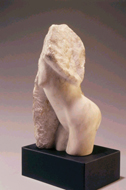SN: Who are you?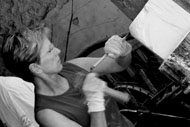
NS: My name is Nichole Sharpe I’m a dreamer, an observer, a questioner, a problem solver and an artist. I live in West Seattle and work in my recently completed home studio.
SN: What is your life history as it relates to being an artist?
NS: My mother was an artist. She did political cartoons as well as working in pastels and oils. Although I felt a strong artistic urge as a child I was quite intimidated by my mother’s talent. So I directed my creative energies into the performing arts. I loved to dance, act and perform. In fact at one point I thought I would become a professional dancer. However, my teen years lead me in a different direction and I started sculpting in clay. When my son was born I felt a need to put the art away and find a way to provide for him. It took about twenty years before I would return to art. While finishing my masters program in Whole Systems Design I was required to design, and produce a pop-up book. That led me into making and casting paper, which lead back to sculpting in clay. Then about nine years ago I took a stone carving workshop taught by Kalia Gentiluomo, and in two afternoons I was hooked. It felt like arriving home.
SN: Why did you become an artist?
NS: I don’t know that one becomes an artist. I think one is an artist and either they are intentionally practicing or not.
SN: Who or what has influenced your art form?
NS: I’m moved and inspired by the rawness and beauty of nature and am intrigued with the connection between humans and the rest of the natural world. I’m also influenced and inspired by the rituals of community interaction and its affect on individuals. I think that is, in part, why I am drawn to observe diverse cultures. I’m particularly interested in African culture and the rawness of life in Africa; out of which can come great beauty.

SN: Why is art important to you?
NS: Art in general and perhaps carving in particular seem able to close out external stimuli, to move within almost meditatively, creating moments of exquisite joy. Working with stone keeps me grounded and in touch with what is important in life.
SN: How does your art reflect your philosophy?
NS: The whole question of how our individual mental, emotional and physical orientation influences our belief in, and understanding of what is real and true, has fascinated me since childhood. I often think about this as I’m working a piece, toying with the idea that the observer and what is observed influence each other. This suggests to me a sense of communication perhaps even a certain co-creation between myself and the observer. I like carving pieces that seem to change distinctly with one’s physical orientation. I think it stimulates the observers to challenge their assumptions.
SN: How has NWSSA influenced your work as an artist?
NS: It has provided for me great opportunities to hang out with some incurably creative, generous, supportive and caring individuals. What a great community to be a part of.
SN: Describe your art in your own terms.
NS: My work is a celebration of the human experience in all its dimensions. When sculpting figurative pieces, I want my work to capture the tie between the fluid beauty of our human form and our ancient connection to the earth. I think in most of my pieces I’m striving for a sense of movement, gracefulness and rhythm. I also play with subtleties and contrasts. I think at least in part I love working with stone because I love seeing how something made of rock can seem soft and tender.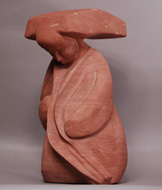
SN: Is it representational and /or non-representational?
NS: I believe that art should transcend the mundane, that it should be more than simply a depiction of the outside world. So although most of my work is figurative I think it would be considered more expressionistic than representational.
SN: How do you get your ideas?
NS: My ideas can come from anywhere. I could be sitting in a café and notice how someone is holding her head. I may observe the language of the body in a particular movement. In some cases it is the stone itself that calls to me to bring out a form. My ideas just come from living my life.
SN: How do you develop them?
NS: Sometimes I’ll make a sketch or model, other times I just start carving and see what shows up.
SN: What is the source of inspiration of your forms, language or imagery?
NS: Although I get my ideas from a multitude of places, my inspiration comes from communing with nature. It is often when I’m out hiking or camping that I begin playing with images in my minds eye. Although I most often carve the human form it is in the wilderness where I’m not around people that I get inspired.
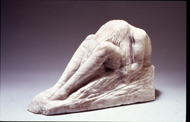
SN: What are you trying to express?
NS: You know that is a really good question. I don’t know that in the big scheme of things, I’m trying to express anything in particular. I think a need to express something comes with each individual piece.
SN: Describe a recent piece or two and what do you like about them?
NS: I recently found myself working with more abstract forms. I’m not sure this will continue but I completed two rather abstract basalt pieces that I like. One is a column which holds within it three different abstract female images. I call it Perspective. The other is a single abstract female image, as of yet only titled Basalt Woman One. I particularly like the Perspective piece because although it has three female images in it, you only see them one at a time as you walk around the sculpture. Therefore it plays on the concept of the relationship of orientation and reality that I mentioned earlier.
SN: What was involved in creating them?
NS: I found both pieces of stone along the Columbia River and knew when I looked at them that they would be abstracted female forms. With Perspective I needed to take care that as I uncovered one figure, I didn’t interfere with the other two I felt sure were in there.
SN: What is the major theme or intent of your art?
NS: Although most of my pieces are figurative, I’m not sure that the human form is really the major theme of my art. Although it has been said that some of my work is a bit provocative it is never edgy or shocking. I’m not looking to put people on edge. I want people to linger with my art to relate to the piece in a relaxed and engaged way. I would say that connection, communication and relationship are the themes I work with. For me I know a piece has turned out well when it has developed a personality that I relate to. And when that happens I feel that the piece will likely relax and engage the observer, allowing the observer to stay in tune with the piece and how it speaks to them.
SN: Do you work full or part time as an artist?
NS: I’m not currently employed other than as an artist.
SN: What is your working process – Do you do one piece at a time or do you have several in process at once?
NS: I usually have several going at one time, in different phases. This works for me because I can give my body a break from any one process.
SN: Where do you exhibit you work?
NS: I have had my work in a number of Western Washington galleries and shows. A personal online gallery is in the works for this winter, where I hope to reach a larger audience.
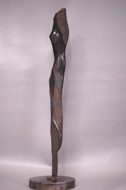
SN: Have you been influenced by any particular artist?
NS: Actually a number of them. What stone sculptor wouldn’t be influenced at least a little bit by Michelangelo? Making the trip to Florence Italy to see his work was one of the highlights of my life, as was my time in the Rodin museum in Paris looking at both Rodin’s and Camille Claudel’s work. I have also been influenced by Modigliani, Brancusi, Georgia O’Keeffe and Beatrice Wood. Some artists have influenced and inspired me through their work and others through their tenacity.
SN: What scale or size do you work in and do you have a favorite scale?
NS: I think the largest piece I’ve completed to date is about 200 lbs. I’ve kept most of my work on the small size because I haven’t had the equipment to move or work larger pieces. However, I recently set up a new indoor and outdoor studio space with a gantry crane. So, I’m hoping to start working on a larger scale. Although I will still need to find a way to move and install larger pieces.
SN: What have been your satisfactions in your life as an artist?
NS: Just being able to make art is totally satisfying. I feel so incredible lucky that after 20 years I was able to return to what feels like me.
SN: What obstacles and challenges have you overcome?
NS: I never had the opportunity to go to school to study art. I am for the most part self taught and as those of you who are also self taught may know, there are times that you make major mistakes that destroy a piece you’ve worked on for months.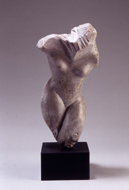
SN: What are you looking forward to?
NS: I have been out of the studio for almost two years because I was busy remodeling a house and trying to get my studio moved. Now that all of that is behind me and my studio is up and running, I’m looking forward to work. Just being able to go to the studio on a regular basis and spend time in that creative space is thrilling for me. I do have to admit I’m also looking forward to putting my on line gallery together and seeing what comes of that.
SN: Any final words?
NS: I have appreciated the chance to give this interview. It has been an occasion for some self reflection as well as for an opportunity to share a bit of my work and self with all of you. Thank you.